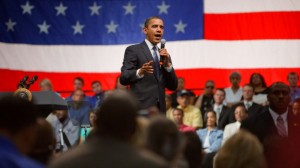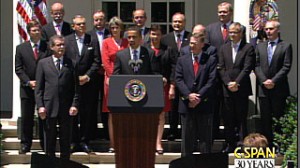
In an historic first, the projected reduction of approximately 900 million metric tons in greenhouse gas emissions sets in motion a policy that says it's America's desire to deal with global warming after decades of denial.
For followers of the auto emissions and fuel economy wars that have been going on for five decades now, the announcement today by President Barack Obama that one “National Fuel Efficiency Policy” is decreed is a clear turning point in America’s growing interest in cleaning the air we all breathe.
It is also a stark demonstration of the growing inability of the auto industry to promote its own narrow self-interests to the detriment of the larger public good.
The proposed National Fuel Efficiency Policy adopts uniform federal standards to regulate both fuel economy and greenhouse gas emissions while preserving the legal authorities of the Department of Transportation (DOT), the Environmental Protection Agency (EPA) and the State of California and 13 other States, according to the President.
The fuel efficiency program covers new vehicle model years 2012 to 2016, and ultimately requires an average fuel economy standard of 35.5 mpg in 2016. An estimated 1.8 billion barrels of oil will not be used by vehicles bought over the five-year life of the program — over an unspecified lifetime of each vehicle. The fuel economy gains of more than 5% per year would have once been unthinkable in lobbyist-dominated Washington.
In an historic first, the projected reduction of approximately 900 million metric tons in greenhouse gas emissions sets in motion a policy that says it’s America’s desire to deal with global warming after decades of refusing to do so. The 35.5 in 2016 is equivalent to taking 177 million cars off the road or shutting down 194 coal plants, according to the Administration.
 The key component in this reduction is the increase in the average mileage requirement from new vehicles that leaves as road kill the existing CAFE law passed by Congress and President Bush in 2007. Back then, under heavy auto industry lobbying, the bill only required an average fuel economy of 35 mpg in 2020.
The key component in this reduction is the increase in the average mileage requirement from new vehicles that leaves as road kill the existing CAFE law passed by Congress and President Bush in 2007. Back then, under heavy auto industry lobbying, the bill only required an average fuel economy of 35 mpg in 2020.
“In the past, an agreement such as this would have been considered impossible,” said President Obama. “That is why this announcement is so important, for it represents not only a change in policy in Washington, but the harbinger of a change in the way business is done in Washington.”

National Fuel Efficiency Policy announcement.
Perhaps, but there are still tough political choices confronting an administration that so far has been good at spending taxpayer’ money, but not in making politically costly decisions to fund that deficit spending.
The National Fuel Efficiency standard is, however, a clear victory for the green movement, and might signal that environmentalists have finally learned that the political art of compromise provides more benefits than insisting on a rigid adherence to extreme ideological positions that allowed the auto industry to forestall even small improvements in fuel economy while the environmentalist demanded impossible increases.
Nonetheless, the program announced today is indeed compromised from several viewpoints, which might prevent it from achieving its stated goals.
Perhaps the most glaring omission is the lack of any increase in the price of fuel to move potential new vehicle buyers away from larger vehicles that they love. The administration is counting on a market-driven rise in fuel prices – it projects gasoline will cost $3.50 a gallon by 2016 — which conveniently lets it of the hook for increasing the price of gasoline, which would enrage voters. It also ensures that such a low fuel price will continue to signal to buyers that larger vehicles are a sound choice.
Studies show that it will take much higher fuel prices than this – perhaps as much as $5-$7 gallon to shift buyer preferences. This means the old CAFE game of automakers looking for credits and offsets so that they can meet the average on paper will likely return. The first such game – credits for electric vehicles that offset more numerous conventional vehicle sales – is already in play.
Another issue is the cost of the program to consumers. As the American middle class keeps shrinking from record ongoing job losses in a failing economy, the estimated cost of compliance from $1,000 to $3,000 per vehicle while likely put new vehicles out of the reach of many more families. Thus, a key aspect of the American dream is eliminated from the business plans that once made the American Auto industry the great economic force for prosperity.
It is noted that China and India are well along in the development and production of lower-cost vehicles for their emerging middle class – vehicles that U.S. customers will not see. What U.S. customers will see is an increase in imports of smaller, fuel efficient vehicles from overseas, thereby further diminishing jobs for U.S. engineers with advanced college degrees.
U.S. employment continued to decline in April as another 539,000 jobs evaporated to total 13.7 million out of work people, and the unemployment rate rose from 8.5% to 8.9%, according to the Bureau of Labor Statistics. Since the recession began in December 2007, 5.7 million jobs have been lost. In April, job losses were large and widespread across nearly all major private-sector industries. Overall, private-sector employment fell by 611,000. Over the past 12 months, the number of unemployed persons has risen by 6.0 million, and the unemployment rate has grown by 3.9 percentage points.
Still, certainty in this contentious area is said to be good for international businesses even if it hurts consumers, college graduates and the U.S. economy in the longer run.
The President put his best interpretation on it: “And at a time of historic crisis in our auto industry, this rule provides the clear certainty that will allow these companies to plan for a future in which they are building the cars of the 21st century,” he said. The lack of a U.S. industrial policy is a glaring omission in today’s announcement. Ten car companies and the UAW have embraced the national program because it provides certainty and predictability to 2016 and includes flexibilities that will significantly reduce the cost of compliance,’ the Administration maintained.
The truth is the car companies had no choice.
Overall growing consumer ecological sentiment, the need for an energy policy to protect us for terrorists, and the California mandate covering 40% of the new vehicle market that is now pre-empted by federal law – all pointed to the need for increased efficiency. And so we move forward.

Comments on today’s announcment by appointees of the President:
“The President brought all stakeholders to the table and came up with a plan to help the auto industry, safeguard consumers, and protect human health and the environment for all Americans,” said EPA Administrator Lisa P. Jackson. “A supposedly ‘unsolvable’ problem was solved by unprecedented partnerships. As a result, we will keep Americans healthier, cut tons of pollution from the air we breathe, and make a lasting down payment on cutting our greenhouse gas emissions.”
—
“A clear and uniform national policy is not only good news for consumers who will save money at the pump, but this policy is also good news for the auto industry which will no longer be subject to a costly patchwork of differing rules and regulations,” said Carol M. Browner, Assistant to the President for Energy and Climate Change. “This an incredible step forward for our country and another way for Americans to become more energy independent and reduce air pollution.”
—
“President Obama is uniting federal and state governments, the auto industry, labor unions and the environmental community behind a program that will provide for the biggest leap in history to make automobiles more fuel efficient,” said Department of Transportation Secretary Ray LaHood. “This program lessens our dependence on oil and is good for America and the planet.”